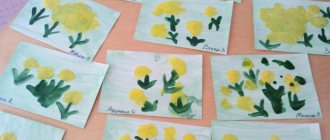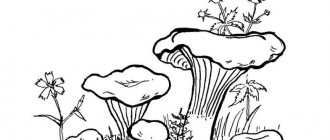Junior group
For children of a younger age group, primitive games are suitable, in which you need to group and separate objects according to parameters.
Find the same one
The teacher shows the figure. The player must find the same object based on one parameter: geometry or color. For example: a yellow triangle is shown. This means you need to find either red and blue triangles, or other yellow shapes.
Find something different
The opposite of the previous task. It is required to find figures that differ from the demonstrated element in a certain parameter: size, color, geometry.
Plant in the beds
For the game you need to prepare improvised beds. The blocks will be vegetable seeds. The teacher gives the task to plant the seeds in certain beds. For example, for the first bed - small and red, for the second - square and yellow.
Feed the toys
To play, you need to place dolls or soft toys on the table. Dienesh blocks will be food. The teacher explains that toys want to eat, but each of them has its own food. For example, a teddy bear eats large yellow figures, and the Masha doll eats small blue ones. The players’ task is to choose the right blocks for each toy.
Goals and objectives
Young children have no problem mastering arithmetic, but they struggle with abstract thinking. When searching for information, a child tends to rely on patterns, but this does not always work out. Dienesh invented a technique through which preschoolers learn about abstract concepts by visualizing them. Dienesh's math blocks are an easy-to-understand and fun way to prepare for school.
The purpose of Dienesh's games is to develop logical and mathematical thinking among kindergarteners and primary schoolchildren.
Tasks:
- training in the skill of analyzing forms, comparing them according to certain parameters;
- creative and intellectual development;
- developing the ability to think logically, build chains of thoughts, and make assumptions;
- formation of responsibility, perseverance, diligence;
- speech development, expansion of individual vocabulary.
The use of Dienesh blocks is relevant in kindergartens and grades 1-2 of primary school. That is, classes are intended for children 2-8 years old.
Middle group
Middle age preschoolers can play with diagrams and pictures. It is advisable to choose creative games with Dienesh blocks so that students use their imagination as much as possible.
Game with pictures
To play, you need to buy or print color pictures depicting different objects in a geometric representation. The child’s task is to correctly place the blocks on the picture. For example, the car wheel shown is a circle. This means you need to apply a round block.
Build a row
The game greatly develops the ability to analyze.
You need to place several blocks so that a clear sequence is formed. The player must understand which piece to place next. For example, a red circle followed by a blue one. Therefore, the third one will be the yellow circle. Or this combination: circle, square, triangle - all red. This means that the fourth figure will be a red rectangle.
What's extra
The game teaches you to group objects according to certain characteristics.
The teacher lays out 3 or 4 figures in front of the child. One should be superfluous, that is, not having a single common feature with the others. The player must point to the wrong object and explain his decision.
When the child begins to cope with it with ease, complicate the task: put 6 figures, of which two should be incorrect.
Point to an object with "not"
The teacher lays out the blocks and names signs with negation. And children must point to the corresponding objects. For example, “this figure is not red” or “this is not a triangle.”
Fix the bridge
To play, you need to prepare cards depicting geometric shapes, indicating their colors and sizes. And also similar cards, but with crossed out images, meaning that the block should not have such signs.
The teacher tells a story about how a bridge broke between the houses of two fairy-tale characters, and the neighbors can no longer see each other. The students' task is to repair the bridge. Only the “bricks” need to be laid not at random, but according to a certain rule, then the structure will be strong and will no longer break.
Next, the teacher shows 1-2 cards with parameters, and the children choose the appropriate “bricks”. For example, cards are shown with a crossed out triangle and an uncrossed red color. This means that the next “brick” for the bridge must be red, but cannot be a triangle.
Which figure disappeared
The game strengthens memory and concentration.
The teacher lays out several blocks in a row. The child tries to remember the sequence, then closes his eyes. The teacher removes one element of the sequence. The pupil, having opened his eyes, must remember what figure was in the place where it is now empty.
The game can be a little more complicated: do not leave an empty space, but replace the removed block with another. Then the player’s task becomes to return a number of figures to their original form. If the child copes well, you can complicate it even more: replace not one, but 2-3 objects.
Constructor
Children love to play with Dienesh blocks as if they were construction sets. This game develops imagination and creative thinking.
Children construct something at the suggestion of the teacher or at their own request. To begin, have students practice constructing using a visual diagram. Then they must use their imagination.
Forms of organizing joint activities
| Children's activities | Forms and methods of organizing joint activities |
| Motor | 1. Outdoor game “Harvesting”. 2. Articulation gymnastics. |
| Gaming | Didactic game “Gifts from Dunno - a bag of fruits.” |
| Productive | Album design - paste pictures of fruits. |
| Cognitive and research | Solving a problem situation (how to grow a square watermelon), experience. |
| Communicative | Questions, speech situations. |
| Perception of fiction | Listening to (and guessing) poetic riddles. |
Dienesha blocks for preschool children
Dienesh blocks look like three-dimensional geometric objects, reminiscent of those from which children usually build houses. However, this is not just a construction set, but material for a whole series of educational and educational games.
The set includes 48 non-repeating shapes. Each object differs from the others in at least one of 4 parameters:
- geometry - circle, square, triangle, rectangle;
- color – red, blue, yellow;
- size – large, small;
- volume - thick, thin.
That is, the set consists of 4 groups of figures of 12 pieces each. Groups of Dienesh blocks allow you to organize many exciting games that teach preschoolers to analyze, compare, generalize, and classify information. The set is supplemented with cards with illustrative, schematic and template images, as well as descriptions of tasks.
Ready-made cards and assignments are in demand; with their help, it is easier for a preschooler to get acquainted with geometric shapes. Based on the schematic image, the child makes a picture. Younger children place blocks directly on the diagram. Older preschoolers lay out the figures next to the schematic image.
The method was invented by educational psychologist Zoltan Dienes. It is an entertaining game form for developing mathematical thinking in children. According to the famous teacher, mastering mathematics is only effective when the child does not get bored. It is difficult for a preschooler to fix information in his mind when he has to listen for a long time and strain his brain. And the game method allows the child to absorb and remember information without stress and fatigue.
The method of teacher Dienesh develops mathematical thinking. For the comprehensive development of a child, it is necessary to use other teaching methods.
Dienesh's method involves 6 learning stages, depending on the age abilities of the children:
- a game without rules - the child learns to work with blocks, he develops mathematical concepts;
- playing by the rules;
- lesson with comparative analysis;
- representation – the child plays in accordance with the proposed methods, focusing on the acquired knowledge;
- creative activities conducted in accordance with logical concepts;
- formalization is that level of classes at which a preschooler is already able to draw conclusions and justifications.


